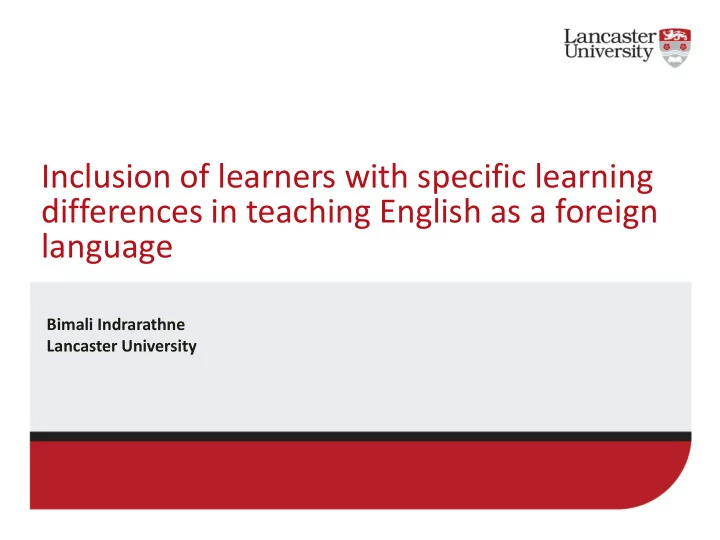

Inclusion of learners with specific learning differences in teaching English as a foreign language Bimali Indrarathne Lancaster University
Introduction My research Input processing Working memory Dyslexia and language learning Working memory Facts Teacher training project for Sri Lanka Who? When?
My research • Attention is a necessary condition for learning (Leow, 2013; Robinson, Mackey, Gass & Schmidt, 2012) • Learners need to pay attention to target language input and identify the language features in the input (Schmidt’s noticing hypothesis, 1995) • Do learners need extra support (e.g., from the teacher) to pay attention to input or can they pay attention to input on their own? – Explicit? – Implicit? • Working memory and input processing – Directing learners’ attention to relevant features in the input (Ellis, 1996) – Processing input (Ellis & Sinclair, 1996)
My research W Explicit 1 O With an explanation of the target structure R K I N Explicit 2 P G P No explanation, but participants were informed O R M that there was a target structure highlighted S E E M T T O Implicit 1 T R E Y No information, target structure highlighted E S S T T E T S Implicit 2 T No information, no highlighting S Control group
My research Participants – 100 undergraduates at a Sri Lankan university – Age between 18-22 – B1/B2 level of proficiency – 20 in a group Pre/post-tests – Sentence Reconstruction items – Grammaticality Judgement items – Free writing task Working memory tests Digit Span, Keep track, Plus minus, Stroop Target structure Causative passive
My research Eye tracking to measure attention – Tobii X2-60 portable eye tracker fixed to a laptop
My research
My research
My research
My research Significantly Explicit 1 higher amount of With an explanation of the target structure attention Explicit 2 Significant No explanation, but the participants were informed that improvement in Higher WM: there was a target structure highlighted the post-test better attention, better Implicit 1 Significantly lesser performance No information, target structure amount of highlighted attention Implicit 2 Very little or no No information, no highlighting improvement in the post-test Indrarathne & Kormos (2016), Indrarathne & Kormos (2017)
Dyslexia, working memory and language learning ELT Well
Dyslexia, working memory and language learning “ Dyslexia is a language-based learning disability ” (International Dyslexia Association, 2012)
Dyslexia, working memory and language learning “ Dyslexia is a language-based learning difference ” (International Dyslexia Association, 2012) Some symptoms: • Slow reading speed • Spelling issues • Mixing up words • Difficult to express themselves clearly • Poor concentration • Ineffective organizational skills • Low self-esteem • Short memory span (lower WM capacity) (International Dyslexia Association, 2012)
Dyslexia, working memory and language learning Significantly Explicit 1 higher amount of With an explanation of the target structure attention Explicit 2 Significant No explanation, but were informed that improvement in Higher WM: there was a target structure highlighted the post-test better attention, better Implicit 1 Significantly lesser performance No information, target structure amount of highlighted attention Implicit 2 Very little or no No information, no highlighting improvement in the post-test
Dyslexia, working memory and language learning Dyslexia facts • 10% of population (estimated) • Occurs in people of all backgrounds and intellectual levels • Runs in families • Dyslexia is not due to either lack of intelligence or a desire to learn • People who are very bright can be dyslexic • Dyslexia is a life-long condition • With proper help people with dyslexia can learn to read and/or write well (International Dyslexia Association, 2012)
Teacher training project for Sri Lanka Partners Project website: http://www.dyslexiaprojectsl.com/
Teacher training project for Sri Lanka • Will educate ca. 100 English language teacher trainers in the country • How to identify learners with dyslexia and how to support them in the English language classroom • Training materials • Free resources and professional development opportunities available • Raise awareness among school principals, policy planners and language testing body of the country • May/June 2017
Teacher training project for Sri Lanka Content • Understanding dyslexia • Effects of dyslexia on language learning • Identifying learners with dyslexia • Classroom management techniques • Teaching vocabulary and grammar • Teaching the four skills • Assessing learners with dyslexia • Challenges and solutions
References Ellis, N.C. (1996). Sequencing in SLA: phonological memory, chunking, and points of order. SSLA, 18 , 91-126. Ellis, N. C., & Sinclair, S. G. (1996). Working memory in the acquisition of vocabulary and syntax: putting language in good order. The Quarterly Journal of Experimental Psychology, 49A (1), 234-250. ELT Well. (2017). http://eltwell.com/ Indrarathne, B. & Kormos, J. (2016). Attentional processing of input in explicit and implicit learning conditions: an eye- tracking study. Studies in Second Language Acquisition. doi:10.1017/S027226311600019X. Indrarathne, B. & Kormos, J. (2017). The role of working memory in processing L2 input: insights from eye-tracking. Bilingualism: Language and Cognition . (in press) International Dyslexia Association .(2012). Dyslexia basics: fact sheet. Available at https://dyslexiaida.org/dyslexia- basics/ Leow, R. (2013). Attention, Noticing, and Awareness in Second Language Acquisition. In C. A. Chapelle (Ed.) The Encyclopedia of Applied Linguistics (pp. 1-7). Oxford, England: Blackwell Publishing Ltd. Robinson, P., Mackey, A., Gass, S. M., & Schmidt, R. (2012). Attention and awareness in second language acquisition. In S. M. Gass & A. Mackey (Eds.), The Routledge handbook of second language acquisition (pp.247-267). London, England: Routledge. Schmidt, R. (1995). Consciousness and foreign language learning: A tutorial on the role of attention and awareness in learning. In R. Schmidt (Ed.), Attention and awareness in foreign language learning (pp 1-63). Honalulu, HI: University of Hawaii, Second Language Teaching and Curriculum Centre.
Thank you
Recommend
More recommend